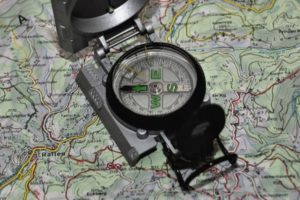Sleeping pads provide you with the cushioning and insulation you’ll need for a good night’s sleep in your tent. There are three types of pads you can buy; Air Pads, Self Inflating Pads and Closed Cell Foam Pads.
Before you set out on your camping trip, you need to decide which pad is best for use on your trip. Some pads, for example, provide the comfort you’ll need for sleeping on a hard, uneven floor while others will keep you warm through long winter nights.
Air Pads
Air Pads are the pads that you blow up until they become the size of a small single mattress. In general, they are very comfortable and can increasingly provide you with the insulation you will need to get you through cold nights.
They are perfect for backpacking because, while deflated, you can roll them up and fit them easily in your rucksack. Their main disadvantage is that you can quite easily puncture them. While you should have no problem fixing smaller punctures, you may have a problem fixing bigger ones, particularly if it is a rip.
Self Inflating Pads
Self-inflating pads are similar to air pads except, as the name suggests, they inflate by themselves. All you need to is to open the pad’s valves, and the air will enter the pad naturally. Their advantage over air pads is that they are made from stronger material and, unlike air pads, don’t lose so much air during the night. You are likely to wake up on a self-inflating pad as firm as it was when you blew it up. The stronger material, however, makes them heavier. While they are a reasonable option for backpacking, they aren’t as viable an option as the lighter and easier to pack air pads.
Closed Cell Foam Pads
Thinner, bulkier and less comfortable, cell foam pads seem like the lesser option until you consider them a little more closely. Closed-cell foam pads are far lighter and far cheaper and than the other two options.
Moreover, you neither have to pump them up nor worry about punctures. You just lay them out on the floor and put your sleeping bag on top. They are the perfect option for those that don’t require a soft mattress like surface for a good night’s sleep.
Sleeping Pad Features
When buying a sleeping bag, you should consider the following features; insulation and R factors, sleeping pad weight, sleeping pad length, sleeping pad width, sleeping pad construction, sleeping pad inflation and sleeping pad surfaces.
Insulation and R Factors
The ground tends to suck out your body heat so good insulation should be an essential feature of any sleeping pad. The most insulated pads are the air pads and the self-inflating pads. All of them should come with a synthetic layer on the inside, but if you are thinking of camping in the unusually cold condition you will want to buy a pad with down insulation – feather insulated pads that trap warm air a lot more efficiently.
Sleeping pads have what is called an R valve, which ranges from a 1.0 to a 9.5. The higher the R valve, the better your sleeping pads will be at retaining heat. So if you are thinking of camping in the winter, you would preferably buy a sleeping pad with an R-valve towards the higher end. It will be more expensive, but it should keep you warm. In general, the thicker the pad, the higher the R-value. Experts recommend that, even in the summer, you shouldn’t buy a pad with an R-valve measurement with less than 3.0.
Sleeping Pad Weight
Most backpackers are looking for a pad that saves weight and usually the more money you spend on your sleeping pad, the lighter it will be. The most expensive is the ultralight sleeping pads, but you can bypass the expense and buy a closed-cell foam pad. They won’t be as comfortable or have as good insulation, but they will be made from a material that is easier to roll up and fix to the bottom of your bag. If you are travelling with your partner, you could save money by buying a two-person sleeping pad.
Sleeping Pad Length
Regular sleeping pads go from 72 inches, and long sleeping pads go from 78 inches. You can buy shorter sleeping pads that provide comfort and warmth for your shoulder and hips only, but you should only consider these for warm conditions. Ideally, you want one that fits your entire body.
Sleeping Pad Width
Sleeping pads tend to go from 20 to 30 inches in width. The width you choose depends not necessarily on your size, but how much you move in your sleep. You don’t want to buy a 20-inch width pad only to wake up in the morning laying on the cold floor.
Sleeping Pad Construction
If you do have a habit of rolling off your pad, you can buy one with rails, or baffles as they are called, that keeps you hemmed in. Other pads, mostly inflatable ones, come with a thicker area at the head that acts as a pillow.
Other Considerations and Tips
- If you are buying an inflatable pad, you may want to buy a hand pump. While it will take up extra space in your rucksack, it will save you time and energy after a long day’s hike. In addition, you may want to by a patch kit to fix your air pad or self-inflating pad if it gets a puncture. Some may already come with one.
- If you are camping in the snow, experts recommend that you bring more than one sleeping pad — for example an air pad and a closed-cell foam pad.
- Try out the air pad before you buy it. At the shop, ask the assistant if you can lie down on it to assess its weight, length, comfort and width.







